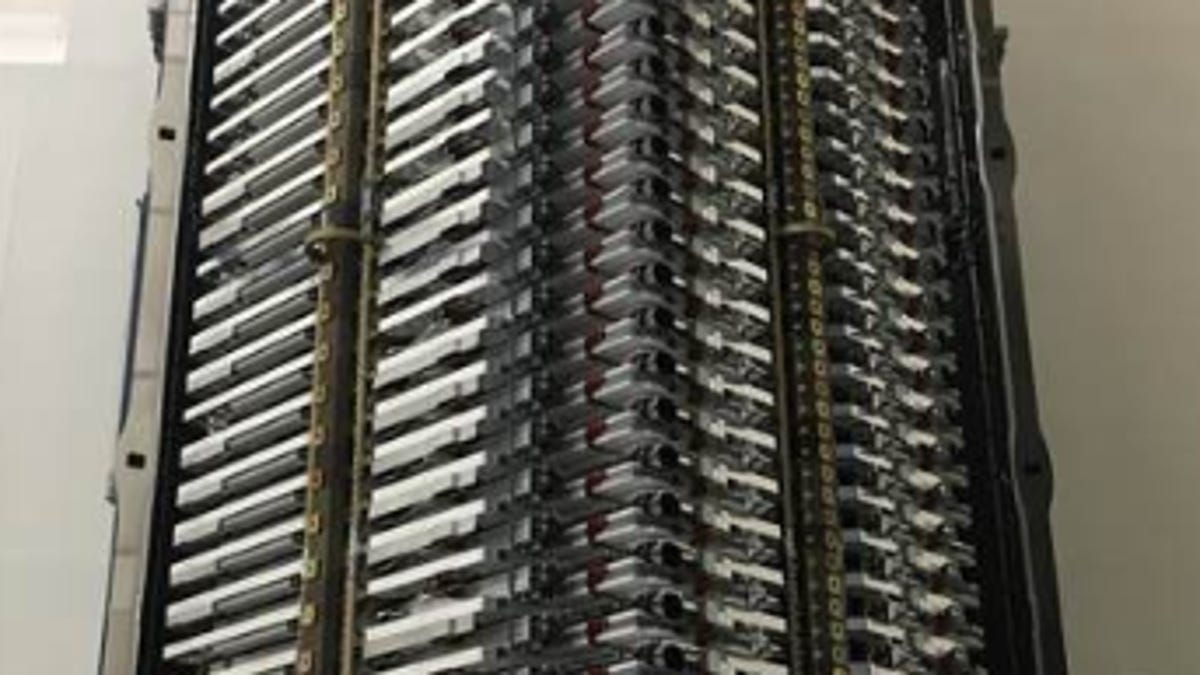SpaceX plan to bring speedy broadband to the world starts now
The first big bundle of Starlink satellites is set to launch Wednesday on a Falcon 9. It could be the start of a whole new way to share Elon Musk memes.

Sixty Starlink satellites have been packed into a Falcon 9.
Yet another Elon Musk plan to shake up an entire industry could get off the ground Wednesday night when a SpaceX Falcon 9 is set to launch the first batch of satellites for the company's Starlink broadband network.
SpaceX launched a pair of prototype satellites for the service last year, but these are the first of the "production design" version of Starlink's satellites.
Earlier in the week, Musk tweeted an image of the 60 satellites all crammed into the fairing of a Falcon 9, which had a successful test firing and is ready to launch as soon as 7:30 p.m. PT Wednesday from Florida's Cape Canaveral Air Force Station.
According to SpaceX COO Gwynne Shotwell, they'll serve as a demonstration and test setup for a constellation of satellites designed to eventually include thousands of the flying data links beaming internet access around the globe.
Musk cautioned that expectations for this first launch should be tempered, saying "much will likely go wrong." He added that six more launches of 60 satellites will be needed for the service to even begin to offer "minor" coverage.
SpaceX hopes to eventually build up the mega constellation to 12,000 satellites. It's essentially a new approach for delivering commercial satellite internet.
Most other satellite internet services, like Viasat or HughesNet, rely on a handful of big satellites in geostationary orbit, over 22,000 miles (35,000 kilometers) above Earth.
Signals and data travel back and forth between those satellites and customers' satellite dishes, as well as larger ground stations on Earth, to bring the internet into the homes of hundreds of thousands of customers, often in rural locations with few other options.
Traveling all those thousands of miles from high orbit can cause high levels of latency when using satellite internet, as anyone who's ever Skyped over such a connection will tell you. Things like real-time video calls and gaming can become difficult when there's lag and delay in the line from data having to travel to space and back over and over again.
So the idea behind Starlink is to use satellites at a much lower orbit to cut down on all that lag time. Sounds great, but there's a catch. Because the satellites will be much closer to the surface of the Earth, they'll only be able to "see" far smaller areas, so a much greater number of them will be required to cover the whole planet.
The company's application to the Federal Communications Commission outlines its plan to begin by deploying an army of over 4,400 small satellites in low Earth orbit between 1,100 kilometers (684 miles) and 1,325 kilometers (823 miles) above us. In April, the FCC also gave the OK for over 1,500 of these satellites to orbit as low as 550 kilometers (342 miles) to reduce space junk. (The satellites will re-enter the atmosphere and burn up sooner at the end of their useful lives.) That'll also put a little more distance between Starlink and satellites from planned competing services like OneWeb, backed by Richard Branson.
Once the first 800 satellites in this constellation are up and running, that will be enough "to provide initial US and international coverage for broadband services," the company says in its FCC application. "Deployment of the remainder of that constellation will complete coverage and add capacity around the world."
A figure from SpaceX's application to the FCC
But that's not all. Once its low-Earth-orbit constellation is up and working, SpaceX hopes to launch an even larger flock of satellites, 7,518 of them to be exact, at an orbit of around 340 kilometers (211 miles) in altitude.
SpaceX says this "VLEO constellation" would provide added capacity where it's needed around the world, "enabling the provision of high speed, high bandwidth, low latency broadband services that are truly competitive with terrestrial alternatives."
SpaceX isn't the only company hoping to operate a constellation of satellites in low Earth orbit. Globalstar and Iridium have operated dozens of satellites for voice services at that altitude for many years, and OneWeb already has approval for a constellation of several hundred broadband satellites. But Musk's plan is arguably more ambitious by an order of magnitude.
To make this audacious plan work, SpaceX has more emerging tech it'll eventually include on each satellite, in the form of lasers allowing them to communicate and coordinate with each other.
The launch of the Starlink's satellites "fires the starting pistol on laser communications use in space to provide connectivity for even the most remote places on Earth," said Markus Knapek, an engineer and board member for laser communications company Mynaric.
You'll still have to wait awhile before you can connect to SpaceX's new network. Musk says the full service probably won't be up and running until the middle of the next decade, just in time for it to help fund his other audacious plans, like sending us to Mars to give Starman a space high five.
Originally published Feb. 20, 2018.
Update, Feb. 21, 2018: Changes launch date and adds confirmation of the test satellites from Musk.
Update, May 14, 2019: Adds information on first launch of 60 production satellites and updates to the orbits of some satellites.
Update, May 15, 2019: Adds details from Shotwell and a information on how to watch the launch.

